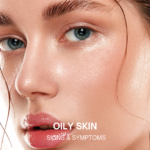Understanding Oily Skin: Causes, Management, and Solutions
Oily skin is a common skin type characterized by excess sebum production. While sebum is necessary for keeping the skin moisturized and protected, an overproduction can lead to a shiny appearance, clogged pores, and acne. Understanding the causes, managing symptoms, and finding effective solutions are crucial for maintaining healthy skin. In this article, we will explore the intricacies of oily skin and provide comprehensive strategies to manage and treat it.
Causes of Oily Skin
- Genetics
- Genetics play a significant role in determining skin type. If your parents have oily skin, you are more likely to inherit this trait. The number and activity level of sebaceous glands are influenced by genetic factors.
- Hormonal Changes
- Hormones, particularly androgens, can increase sebum production. Adolescence, menstrual cycles, pregnancy, and menopause are times when hormonal fluctuations can exacerbate oily skin.
- Diet
- Certain dietary choices can influence oil production. Diets high in refined sugars, dairy, and unhealthy fats can trigger inflammation and increase sebum production. Conversely, a diet rich in fruits, vegetables, and whole grains can support skin health.
- Environmental Factors
- Humidity and heat can stimulate the sebaceous glands, leading to more oil production. Living in a hot, humid climate can exacerbate oily skin.
- Overuse of Skincare Products
- Using harsh skincare products or over-cleansing can strip the skin of its natural oils, causing it to produce even more oil as a defense mechanism.
Managing Oily Skin
- Cleansing
- Use a gentle, foaming cleanser twice a day. Avoid harsh soaps and cleansers that can irritate the skin and increase oil production. Ingredients like salicylic acid or benzoyl peroxide can help reduce oil and prevent acne.
- Exfoliation
- Exfoliate regularly to remove dead skin cells that can clog pores. Use a gentle exfoliant containing alpha hydroxy acids (AHAs) or beta hydroxy acids (BHAs) to keep pores clear without irritating the skin.
- Moisturizing
- Contrary to popular belief, oily skin still needs moisturizer. Choose a lightweight, oil-free, non-comedogenic moisturizer to keep your skin hydrated without clogging pores.
- Sun Protection
- Use a broad-spectrum sunscreen with at least SPF 30 every day. Look for sunscreens labeled as oil-free or non-comedogenic to avoid clogging pores.
- Diet and Hydration
- Maintain a balanced diet rich in antioxidants, vitamins, and minerals. Drink plenty of water to keep your skin hydrated from within.
- Avoid Touching Your Face
- Avoid touching your face throughout the day to prevent transferring oil, dirt, and bacteria from your hands to your face.
Effective Solutions and Treatments
- Topical Treatments
- Over-the-counter products containing benzoyl peroxide, salicylic acid, or retinoids can help manage oily skin and prevent acne. Prescription medications like tretinoin or adapalene may be recommended for more severe cases.
- Clay Masks
- Clay masks, particularly those containing kaolin or bentonite, can absorb excess oil and help unclog pores. Use a clay mask once or twice a week for best results.
- Blotting Papers
- Blotting papers are a convenient way to remove excess oil throughout the day without disturbing your makeup. Gently press the blotting paper against your skin to absorb the oil.
- Professional Treatments
- Dermatologists can offer professional treatments like chemical peels, laser therapy, and microdermabrasion to manage oily skin and improve its appearance. These treatments can help control oil production and reduce the occurrence of acne.
- Consistent Skincare Routine
- Consistency is key in managing oily skin. Establish a regular skincare routine and stick to it. Sudden changes in products or routines can trigger skin reactions and increase oil production.
Myths and Misconceptions
- Oily Skin Doesn’t Need Moisturizer
- Many people with oily skin avoid moisturizers, fearing they will make their skin oilier. However, using the right type of moisturizer is crucial to maintain skin hydration and balance.
- Frequent Washing Reduces Oiliness
- Washing your face excessively can strip the skin of its natural oils, prompting it to produce even more oil. Stick to washing your face twice a day with a gentle cleanser.
- Oily Skin Ages Better
- While it is true that oily skin may show fewer wrinkles, it is still susceptible to other signs of aging, such as enlarged pores and skin texture issues. A good skincare routine is essential for all skin types.
Conclusion
Oily skin can be challenging to manage, but with the right approach, it is possible to maintain healthy, clear skin. Understanding the underlying causes of oily skin and adopting a consistent skincare routine tailored to your skin type can make a significant difference. Remember to choose gentle, non-comedogenic products and avoid over-cleansing or using harsh treatments. By following these guidelines, you can effectively manage oily skin and enjoy a balanced, glowing complexion.
Incorporating lifestyle changes, such as a balanced diet and proper hydration, along with professional treatments when necessary, can further enhance your skincare regimen. With patience and persistence, managing oily skin becomes a manageable task, leading to healthier, more radiant skin





